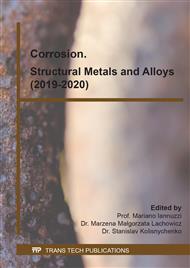[1]
M. F. M. Nazeri, M. N. Masri, and A. A. Mohamad, Post-Corrosion Mechanical Analysis of Sn-Zn Alloys: A Short Review, IOP Conference Series: Materials Science and Engineering, 701 (2019) p.012049.
DOI: 10.1088/1757-899x/701/1/012049
Google Scholar
[2]
M. F. M. Nazeri, M. Z. Yahaya, A. Gursel, F. Cheani, M. N. Masri, and A. A. Mohamad, Corrosion characterization of Sn-Zn solder: a review, Soldering & Surface Mount Technology, (2019).
DOI: 10.1108/ssmt-05-2018-0013
Google Scholar
[3]
M. Zamri, S. N. Athirah, M. A. Sulaiman, S. Ismail, and M. N. Masri, Bacto-Agar and commercial agar as binder for porous zinc anode, Solid State Phenomena, 264 (2017) pp.136-139.
DOI: 10.4028/www.scientific.net/ssp.264.136
Google Scholar
[4]
A. Zahid, M. Masri, M. Hussin, and M. A. Bakar, The preliminary study on cassava (Manihot Esculenta) as gel polymer electrolyte for zinc-air battery, AIP Conference Proceedings, 2030 (2018) p.020278.
DOI: 10.1063/1.5066919
Google Scholar
[5]
M. Abtew and G. Selvaduray, Lead-free solders in microelectronics, Materials Science and Engineering: R: Reports, 27, 5-6 (2000) pp.95-141.
DOI: 10.1016/s0927-796x(00)00010-3
Google Scholar
[6]
S. Jayesh and J. Elias, Experimental Investigations on Impact Toughness and Shear Strength of Lead Free Solder Alloy Sn–0.5 Cu–3Bi–xAg, Transactions on Electrical and Electronic Materials, (2020) pp.1-7.
DOI: 10.1007/s42341-019-00167-x
Google Scholar
[7]
A. M. Delhaise et al., Thermal Preconditioning and Restoration of Bismuth-Containing, Lead-Free Solder Alloys, Journal of Electronic Materials, 49, (2020) pp.116-127.
DOI: 10.1007/s11664-019-07666-w
Google Scholar
[8]
D. Frear, J. Jang, J. Lin, and C. Zhang, Pb-free solders for flip-chip interconnects, Jom, 53, 6 (2001) pp.28-33.
DOI: 10.1007/s11837-001-0099-3
Google Scholar
[9]
C. M. Miller, I. E. Anderson, and J. F. Smith, A viable tin-lead solder substitute: Sn-Ag-Cu, Journal of electronic materials, 23, 7 (1994) pp.595-601.
DOI: 10.1007/bf02653344
Google Scholar
[10]
Z. Xia, Z. Chen, Y. Shi, N. Mu, and N. Sun, Effect of rare earth element additions on the microstructure and mechanical properties of tin-silver-bismuth solder, Journal of electronic materials, 31 (2002) pp.564-567.
DOI: 10.1007/s11664-002-0126-3
Google Scholar
[11]
A. K. Gain and L. Zhang, Microstructure, mechanical and electrical performances of zirconia nanoparticles-doped tin-silver-copper solder alloys, Journal of Materials Science: Materials in Electronics, 27 (2016) pp.7524-7533.
DOI: 10.1007/s10854-016-4732-x
Google Scholar
[12]
S. Jayesh and J. Elias, Experimental Investigation on the Effect of Ag Addition on Ternary Lead Free Solder Alloy–Sn–0.5 Cu–3Bi, Metals and Materials International, 26 (2020) pp.107-114.
DOI: 10.1007/s12540-019-00305-3
Google Scholar
[13]
G. Zeng et al., The influence of Ni and Zn additions on microstructure and phase transformations in Sn–0.7 Cu/Cu solder joints, Acta Materialia, 83 (2015) pp.357-371.
DOI: 10.1016/j.actamat.2014.10.003
Google Scholar
[14]
Y. Min, L. Xiuzhong, L. Xinghong, and D. Jiahui, Development of Sn-Zn-Cu lead free solder, 11th International Conference on Electronic Packaging Technology & High Density Packaging, (2010) pp.784-788.
DOI: 10.1109/icept.2010.5582695
Google Scholar
[15]
C. Yu, H. Lu, and S. Li, Effect of Zn addition on the formation and growth of intermetallic compound at Sn–3.5 wt% Ag/Cu interface, Journal of alloys and compounds, 460 (2008) pp.594-598.
DOI: 10.1016/j.jallcom.2007.06.031
Google Scholar



